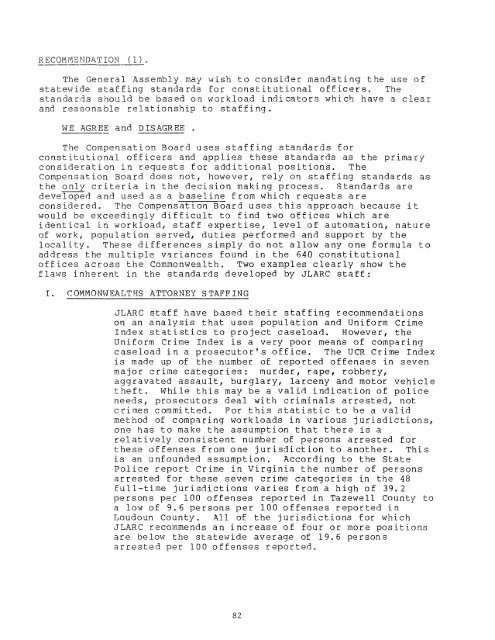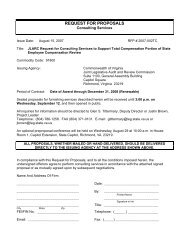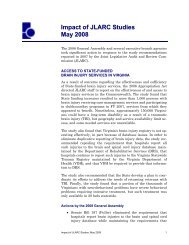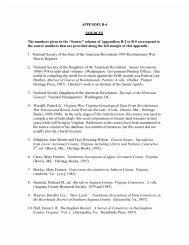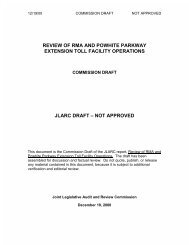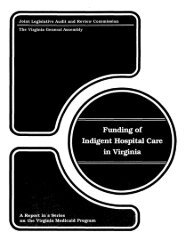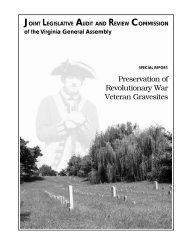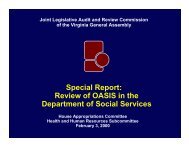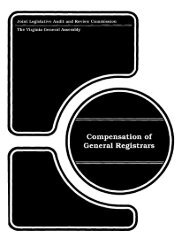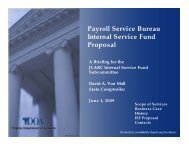Funding of Constitutional Officers - Virginia Joint Legislative Audit ...
Funding of Constitutional Officers - Virginia Joint Legislative Audit ...
Funding of Constitutional Officers - Virginia Joint Legislative Audit ...
You also want an ePaper? Increase the reach of your titles
YUMPU automatically turns print PDFs into web optimized ePapers that Google loves.
RECOMMENDATION 1.<br />
The General Assembly may wish to consider mandating the use <strong>of</strong><br />
statewide staffing standards for constitutional <strong>of</strong>ficers. The<br />
standards should be based on workload indicators which have a clear<br />
and reasonable relationship to staffing.<br />
WE AGREE and DISAGREE .<br />
The Compensation Board uses staffing standards for<br />
constitutional <strong>of</strong>ficers and applies these standards as the primary<br />
consideration in requests for additional positions. The<br />
Compensation Board does not, however, rely on staffing standards as<br />
the only criteria in the decision making process. Standards are<br />
developed and used as a baseline from which requests are<br />
considered. The Compensation Board uses this approach because it<br />
would be exceedingly difficult to find two <strong>of</strong>fices which are<br />
identical in workload, staff expertise, level <strong>of</strong> automation, nature<br />
<strong>of</strong> work, population served, duties performed and support by the<br />
locality. These differences simply do not allow anyone formula to<br />
address the multiple v~riances found in the 640 constitutional<br />
<strong>of</strong>fices across the Commonwealth. Two examples clearly show the<br />
flaws inherent in the standards developed by JLARC staff:<br />
I. COMMONWEALTHS ATTORNEY STAFFING<br />
JLARC staff have based their staffing recommendations<br />
on an analysis that uses population and Uniform Crime<br />
Index statistics to project caseload. However, the<br />
Uniform Crime Index is a very poor means <strong>of</strong> comparing<br />
caseload in a prosecutor's <strong>of</strong>fice. The UCR Crime Index<br />
is made up <strong>of</strong> the number <strong>of</strong> reported <strong>of</strong>fenses in seven<br />
major crime categories: murder, rape, robbery,<br />
aggravated assault, burglary, larceny and motor vehicle<br />
theft. While this may be a valid indication <strong>of</strong> police<br />
needs, prosecutors deal with criminals arrested, not<br />
crimes committed. For this statistic to be a valid<br />
method <strong>of</strong> comparing workloads in various jurisdictions,<br />
one has to make the assumption that there is a<br />
relatively consistent number <strong>of</strong> persons arrested for<br />
these <strong>of</strong>fenses from one jurisdiction to another. This<br />
is an unfounded assumption. According to the State<br />
Police report Crime in <strong>Virginia</strong> the number <strong>of</strong> persons<br />
arrested for these seven crime categories in the 48<br />
full-time jurisdictions varies from a high <strong>of</strong> 39.2<br />
persons per 100 <strong>of</strong>fenses reported in Tazewell County to<br />
a low <strong>of</strong> 9.6 persons per 100 <strong>of</strong>fenses reported in<br />
Loudoun County. All <strong>of</strong> the jurisdictions for which<br />
JLARC recommends an increase <strong>of</strong> four or more positions<br />
are below the statewide average <strong>of</strong> 19.6 persons<br />
arrested per 100 <strong>of</strong>fenses reported.<br />
82


